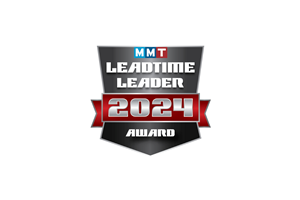Five Tips for Keeping U.S. Customers Ashore
In this trying time of global competition, moldmakers need to take a proactive approach to keeping business in the U.S.
Don't get Glenn Crossno and Gary Hengeveld, co-founders of Inland Technologies (Fontana, CA), started on the topic of overseas outsourcing for injection molded plastic tools and parts. You are liable to get a bit more than you expected to hear about the biggest challenge ever to face the industry in the new century.
"Moldmakers that were in business for 40 to 50 years now are gone," says Crossno. "In the heavily industrialized states like Pennsylvania, Illinois and Michigan, and some in Southern California, the estimated shop closure rate is more than 50 percent over the last two years and is continuing to grow. I've talked with many moldmaking shops that are slow and they attribute the slump to their customers' exodus to overseas companies where the work is done cheaper."
Crossno adds that, "In fact, more and more molds are not allowed to be quoted in the U.S. because manufacturers - our potential customers - assume that no matter what we do, the quote will go overseas for a cheaper price."
But both executives are quick to point out that "price is not always the cost." The true cost of building a mold overseas often is not calculated when the quotes are submitted. Hengeveld says that many potential customers, especially those in the medical device industry - which makes up about 80 percent of Inland Technologies' business - are still adamant about quality and the ability to get their new products to market quickly so they can remain competitive.
Whether in the non-medical or healthcare industries, Crossno and Hengeveld believe they have found five basic successful ways for mold and toolmaking companies to win the bidding war with China and other overseas competitors:
Cut Operating Costs Without Compromising Quality
Companies like Inland Technologies and other shops that are under ISO 9001, FDA and other standards can ensure lower failure rates than moldmaking and tooling shops that do not maintain a controlled environment with Class 100,000 cleanrooms, consistent temperatures, energy-efficient lighting and thermal cooling instead of conventional air-conditioning.
"All of these factors translate into lower rejection rates," says Hengeveld. "And that means higher productivity. It is pretty simple. By increasing the frequency of parts inspections during the production cycle, you also are assuring the highest quality possible, lowering labor costs and keeping production on or ahead of schedule."
Avoid the Middlemen
Most companies outsource their tooling and molding requirements to other specialists. Typically in the injection molding industry, the customer will go to separate moldmakers and tool builders who both mark up their prices. Additionally, says Hengeveld, "Production problems or complications can (and often do) lead to finger pointing between the moldmaker and the molder. This can result in serious delays that jeopardize the product's introduction to market and lead to lost revenues. If all of your operations are in-house, there are no middlemen and you won't have the problems. We have found, for instance, that by being a full-service company, complete with solid modeling and software capabilities, we can take the customer's concept to tooling and to finished product in a very short period of time for big cost savings."
Consider the "True" Costs of Overseas Outsourcing
Crossno advises customers that before they accept the attractive low bids from overseas suppliers, they should consider the "true costs" involved, such as international tariffs, freight charges and travel expenses. "It is far easier for customers to be directly involved in all stages of the mold design and production process when all parties are on the same continent," he says.
"When an engineer travels across the world, it might cost the employer about $40 per hour or $2,000 a week. The company needs to consider the time that engineer is spending away from the workplace and the cost of paying someone else to do the work," adds Crossno. "Companies like ours can save our customers an estimated 70 percent by eliminating the unnecessary expenses associated with travel, communications and delays in meeting timeline demands."
Another factor often overlooked by customers seeking to cut corners by outsourcing - internationally or domestically - is tooling warranties. They need to make sure their suppliers offer evergreen warranties on their tooling, notes Crossno. "Without them, you could end up paying hundreds to thousands of dollars for tool refurbishment each time you need to put your product back into production."
Show Off Your Plant
Hengeveld strongly recommends taking your prospective customers on a thorough tour of your facilities, pointing out most of the cost-saving technology and methods used to produce the finished product. "Demonstrate to them firsthand how you can achieve maximum quality while remaining efficient and meeting their deadlines," he says.
Know Your Customer
Finally, both Hengeveld and Crossno emphasize the importance of demonstrating that you fully understand your prospective customers' industries, their markets and their particular needs and requirements. By doing that, you also are assuring them that your company is the perfect match for meeting those needs, they say.
"Remember, your customers are investing heavily in their next generation of products," says Crossno. "They are pinning their entire marketing platform and budgets around these products. And they are not going to risk the future of their business by taking shortcuts. Once the message is driven home that the lowest price doesn't guarantee quality and on-time delivery, they will bring their business to you."
Related Content
FAQs: What Are the Leadtime Leader Awards?
Here are answers to some frequently asked questions about MoldMaking Technology's annual Leadtime Leader Awards competition.
Read MoreThink Safety: Eliminate Hazards Throughout the Shop
The tooling community is taking advantage of new products for safer mold shops and molding facilities.
Read MoreTreatment and Disposal of Used Metalworking Fluids
With greater emphasis on fluid longevity and fluid recycling, it is important to remember that water-based metalworking fluids are “consumable” and have a finite life.
Read MoreVIDEO: What You Need to Know about the R&D Tax Credit Today
A team member from Strike Tax Advisory reviews the tax changes that are impacting the R&D credits for mold builders.
Read MoreRead Next
Are You a Moldmaker Considering 3D Printing? Consider the 3D Printing Workshop at NPE2024
Presentations will cover 3D printing for mold tooling, material innovation, product development, bridge production and full-scale, high-volume additive manufacturing.
Read MoreHow to Use Continuing Education to Remain Competitive in Moldmaking
Continued training helps moldmakers make tooling decisions and properly use the latest cutting tool to efficiently machine high-quality molds.
Read More



















